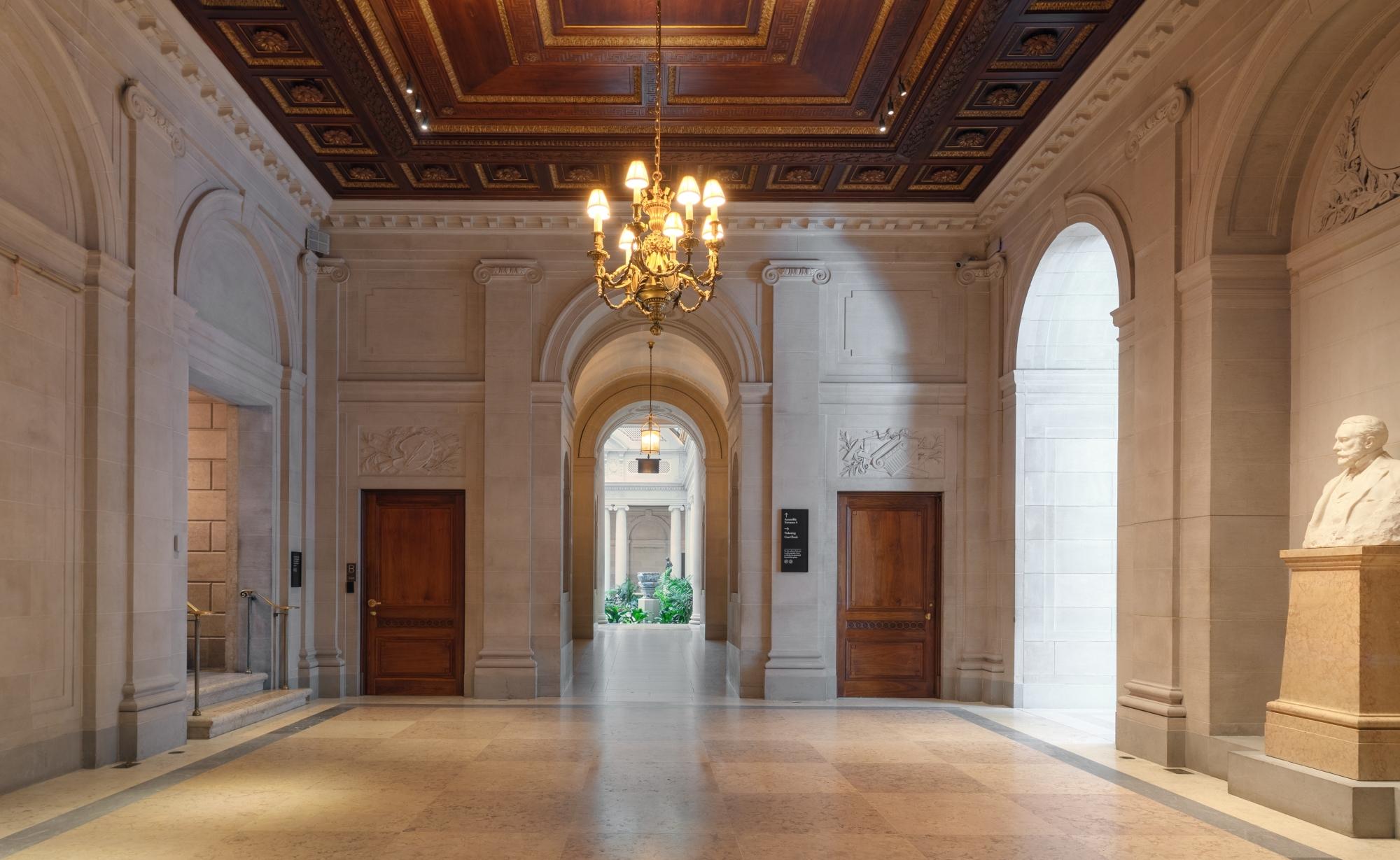Post Date: 05/07/25
Lighting The Frick: A Conversation with Jenny Ivansson of L’Observatoire

Jenny Ivansson
Project Director
L’Observatoire International
www.lobsintl.com
Originally from Växjö, Sweden, Jenny Ivansson earned her MFA in Architectural Lighting Design from Parsons School of Design in New York. She began her career in industrial design, creating luminaires, but soon became fascinated by how lighting shapes architectural experiences, affects human psychology, and can emulate natural circadian rhythms.
Ivansson joined L’Observatoire International in 2014 after eight years in the field. She has worked on prestigious projects including the Philadelphia Museum of Art, the Dwight D. Eisenhower Memorial with Gehry Partners, The Grill at the Seagram Building, the British Galleries at The Met, and the Aoyama Global Treehouse in Tokyo. Her current projects include the Frick Collection in New York and the Desert Storm/Desert Shield Memorial in Washington D.C.

Lighting Design & Litelab’s Role
Nada:
What were the specific lighting challenges in illuminating a historic art collection while maintaining conservation standards?
Jenny:
When working with historic art, the key challenge is balancing proper illumination with conservation. Whether modern or historic, artwork needs to be lit in a way that brings out colour and texture while protecting it from overexposure—especially to daylight and UV rays.
At the Frick, many galleries featured outdated skylights with no UV protection—just old chicken wire glass—exposing artworks to high levels of uncontrolled daylight. Our goal was to reduce that exposure dramatically without losing the ambiance of natural light. We achieved this through an impressive collaborative effort, installing a new skylight system and performing extensive mock-ups to test daylight levels.
Litelab’s role was crucial. Their fixtures sit beneath the skylight and supplement natural light with focused accent lighting. We replaced the old track systems with Litelab’s BusRun system and C2O heads, which offer precision and allow us to dim each head individually to control light exposure per artwork.
The fixtures were customized with a bronze finish to blend seamlessly with the historic mullions. The results are subtle and respectful—almost as if the fixtures have always been there.

Nada:
Why did you choose Litelab fixtures and tracks for this project?
Jenny:
While we often work with several museum-quality lighting manufacturers, Litelab stands out for their form factor and customization options. In this case, it wasn’t about altering performance but achieving the right finish. Their clean, cylindrical design integrates beautifully with historic architecture, unlike some more technical-looking European brands.
We were able to powder-coat the fixtures to match the bronze mullions and create a look that feels native to the space. That kind of visual harmony is essential in a place like the Frick.
Nada:
How does the new lighting enhance how visitors experience the artwork and architecture?
Jenny:
A lot of the enhancement comes from how we simulate daylight. In skylit galleries, we introduced layers of electric light above the laylights that mimic daylight when natural levels are low. It's so well integrated that many visitors don’t realize it’s artificial. The idea isn’t to fool anyone—it’s to maintain a consistent, uplifting experience regardless of the time of year.
We’ve also balanced cooler daylight tones with warmer, neutral white light on the artwork, which really makes the colours pop without overwhelming the pieces.
Sustainability and Design Intent
Nada:
How does the lighting design support sustainability?
Jenny:
Though this wasn’t a LEED-certified project, we were very conscious of energy efficiency. All light sources specified are LED, which is standard today but wasn’t necessarily ten years ago.
The mansion itself has a domestic feeling, so we worked to balance decorative, warm lighting with efficient sources. All chandeliers and sconces now use LED retrofit bulbs at warm colour temperatures to mimic incandescent light.
The rebuilt skylight system also contributes to sustainability. The old glazing allowed excess heat into the building, forcing the HVAC to work harder. The new system is thermally insulated, improving the building envelope and reducing energy use overall.
Nada:
What role does lighting play in setting the mood and atmosphere of the Frick?
Jenny:
Lighting is everything—it shapes how visitors perceive both art and space. The Frick has this unique juxtaposition of natural light, warm decorative lighting, and neutral-white art lighting. That mix can be tricky, especially from a conservation standpoint, but it’s also what gives the space its magic.
For example, curators were initially concerned about using 3000K light on the artwork while having nearby chandeliers at 2200K. But with thoughtful placement and high-quality fixtures, we achieved a beautiful harmony. Visitors experience a soft rhythm of light and shadow as they move through darker passages into brighter, skylit spaces.
Nada:
How has the lighting improved visibility and appreciation of the artwork?
Jenny:
Before the renovation, lighting across the museum was inconsistent. Fixtures had been added over time in an ad-hoc way, and it showed. This project allowed us to unify the approach—no more patchwork solutions.
We replaced all picture lights in non-daylit galleries with high-CRI LED versions, offering exceptional colour rendering and minimal glare. Combined with chandeliers for ambient light, each piece of art is now properly lit to highlight texture, detail, and tone.
Nada:
Can you describe a specific gallery where lighting had a dramatic impact?
Jenny:
Definitely, the Garden Court—the central atrium. It used to feel dim and a bit lifeless. We cleaned and restored the skylight, added Ketra lighting to tune the ambiance, and updated the surrounding finishes and plants.
Now it feels alive—the stone glows, the fountain sparkles, and the room draws attention like it never did before. The transformation is remarkable.

Collaboration & Process
Nada:
Were there any unexpected discoveries during the design process?
Jenny:
Absolutely. One major challenge was the unpredictability of working with historic architecture. For example, in the second-floor galleries—formerly family bedrooms—we found unexpected beams and almost no ceiling depth. We had to quickly adapt our designs to fit the existing structure.
We also built a quarter-scale mock-up of the West Gallery to test materials, angles, and glare control. It helped us avoid ceiling reflections in the paintings—crucial for oil artworks.
Nada:
What lessons from this project will guide future museum renovations?
Jenny:
Multidisciplinary collaboration was key. We worked closely with daylight consultants, conservationists, and architects. Everyone brought expertise to the table, and there was a strong sense of mutual respect.
Sometimes, in big projects, egos or siloed thinking can derail progress. That wasn’t the case here. The Selldorf team and the Frick staff were incredibly receptive, and that made all the difference.
Nada:
What were the most technically challenging spaces to light?
Jenny:
The second floor, without a doubt. Those rooms weren’t originally galleries, so we faced historic finishes, low ceilings, and fragile materials. We couldn’t drill or damage anything.
To solve that, we added miniature accent lights directly onto chandeliers, so we could light the art from the fixtures themselves. The key was reversibility—everything we did had to be removable without leaving a trace.
Nada:
Were there any unexpected obstacles or surprises?
Jenny:
Yes—aside from structural surprises like hidden beams, the biggest challenge was consensus. Conservationists, curators, and designers often have very different ideas about how art should be lit. There’s no one-size-fits-all answer. It became a diplomatic exercise—balancing opinions while staying true to the design vision. In the end, it was about creating a system flexible enough to satisfy a variety of perspectives.
Nada:
That’s an incredible amount of detail and care. Thank you so much for sharing this experience with us.
Jenny:
Thank you! It was a pleasure to be part of such a meaningful transformation.

The full interview can be found here

